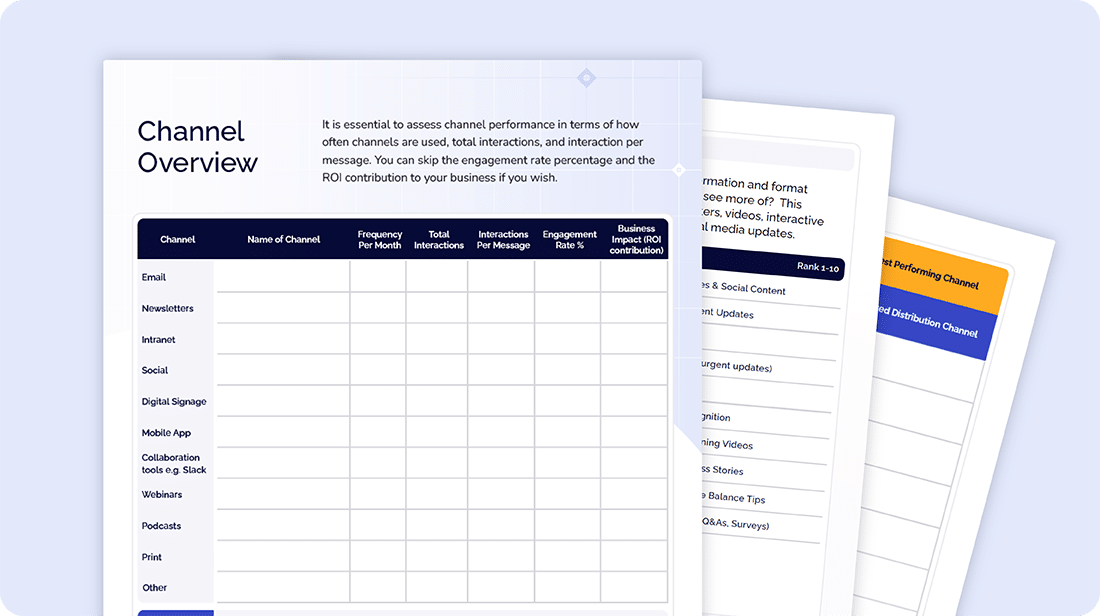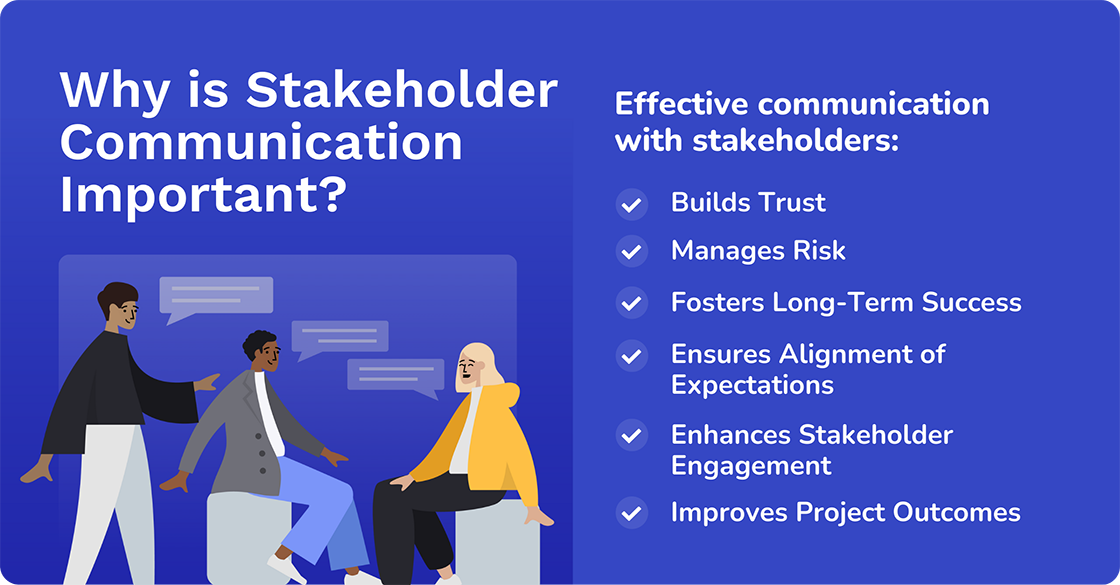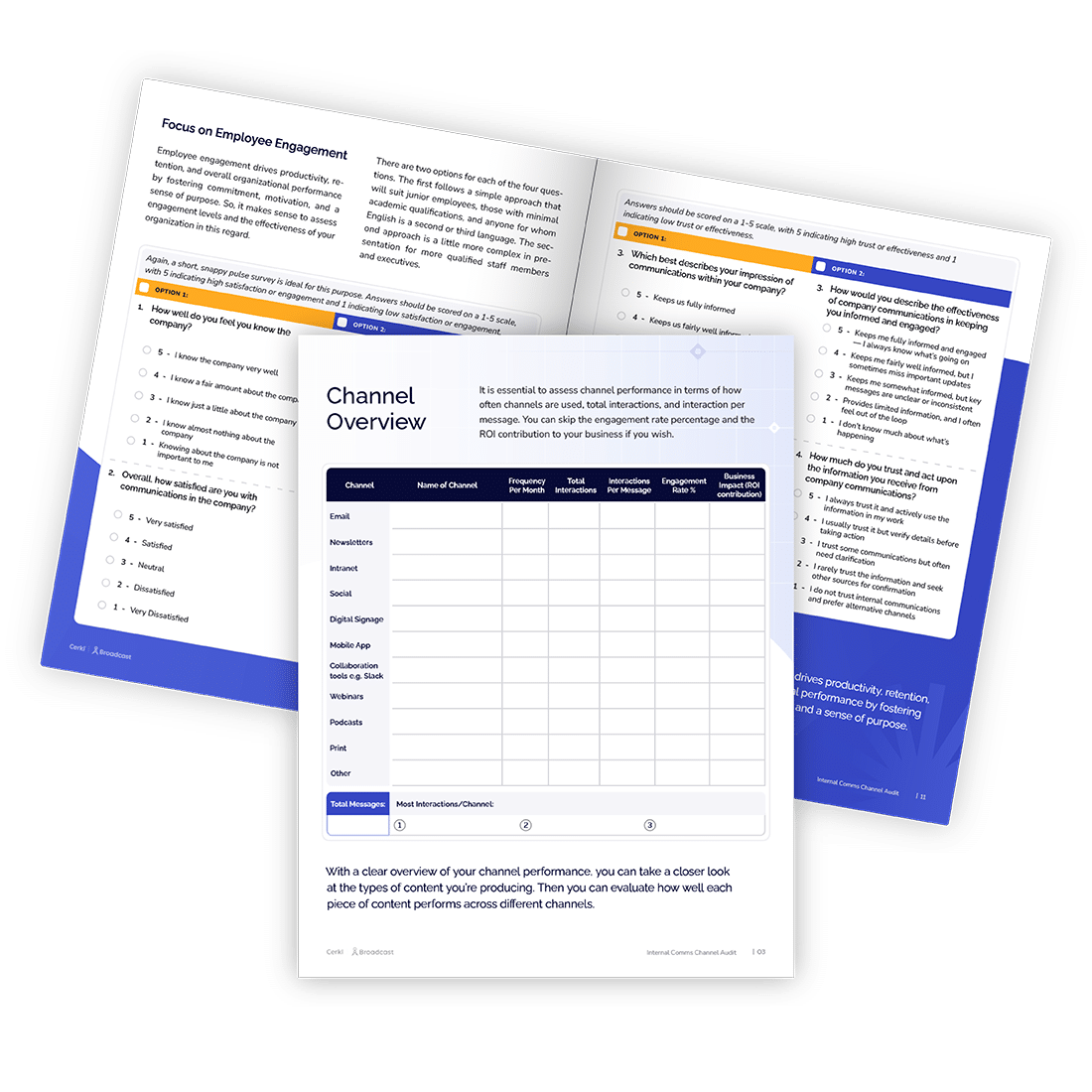Stakeholder Communication: Does One-Size Plan Fits All?
How important do you think stakeholder communication is? You might be surprised to find that it can be one of the most vital elements for the success of your business.

.png)
Audit Your Internal Communications
Strategy is an important component of internal communications. Ensure you’re communicating through the right channels at the right frequency with our Internal Communications Channel Audit worksheet.
Access NowRegardless of the size or niche of an organization, effective communication with stakeholders is paramount for business success. Understanding who exactly the stakeholders are, their needs and expectations, and crafting a tailored communication plan that suits each type is not just an option, it’s a necessity.
Lis Anderson, founder and director of the PR consultancy firm AMBITIOUS, has more than 25 years of experience in the communications industry. She knows that stakeholder engagement is integral to the growth and success of every company. In a Forbes article, How To Create An Effective Stakeholder Communication Plan, she shows how it can help shape projects and campaigns, unlock useful resources, provide support for project managers, and “incite notable collaboration.”
She also shows that it’s vital to maintain and manage a stakeholder communication plan to ensure success.
“Stakeholder engagement and management should be an ongoing exercise that only develops further with time and resources.”
Lis Anderson
Free Internal Comms Audit Template to Improve Engagement
Upgrade your company’s internal comms to enhance employee communication

Download Free
What is a Stakeholder?
Before you can identify a stakeholder communication plan you need to know who your stakeholders are. So, it stands to reason that understanding what a stakeholder is forms the foundation for effective communications with stakeholders.
Essentially, a stakeholder is any individual or group that has an interest or stake in a project, business, or endeavor. This can range from investors and employees to customers and the broader community. Stakeholders can influence — or be influenced by — the project's outcomes, making engagement crucial for success.
For instance, in the software development process, stakeholders might include the project team, end-users, and even regulatory bodies. Each stakeholder group has distinct interests and levels of influence over the project, requiring tailored approaches for interaction. Recognizing stakeholders early in a project ensures their needs and expectations can be addressed effectively.

Types of Stakeholders
Stakeholders are often categorized into two main types: internal and external. Internal stakeholders are those within an organization, such as employees, managers, and owners. They are directly involved in the organization's operations and strategies. On the other hand, external stakeholders are outside the organization and include customers, suppliers, competitors, and government agencies. Both types play a vital role in any organization's ecosystem.
So, for instance, for projects handling child care or early childhood systems, stakeholders might include parents, local government bodies, non-profit organizations, and educational institutions. Each stakeholder type presents unique perspectives and requirements, driving the need for diversified communication strategies.
Before you go any further, you need to identify who your stakeholders are. Then you need to ask yourself which of them will have an interest in your business or any project you are planning.
Why is Stakeholder Communication Important for Every Business?
We’ve looked at different types of stakeholders, but what exactly is stakeholder communication?
Essentially, stakeholder communication is the two-way exchange of information between a company and the individuals or groups that affect, or are affected by its operations. They include everyone from team members and project managers to company executives and department heads. And media used for this kind of communication includes emails and meetings that can be in person or carried out via video streams.
It involves understanding stakeholder needs, proactively sharing information, and addressing concerns. Effective communication with stakeholders builds trust, manages risk, and fosters long-term success.
Stakeholder communication also ensures that a project or business aligns with the needs, expectations, and objectives of all involved parties. Effective communication can lead to improved project outcomes, enhanced stakeholder engagement, and increased trust. Sticking with early childhood systems, and engaging stakeholders through regular updates can foster a supportive community and drive better outcomes for childcare initiatives.
Stakeholders often provide valuable insights and feedback that can help in refining project scopes, identifying potential issues early on, and exploring implementation steps more efficiently. This collaborative approach not only mitigates risks but also boosts stakeholder satisfaction and loyalty.
This is very important as communicators face the challenge of convincing leadership and stakeholders about the value of their efforts intended to secure support for investing in new tools that can bring about meaningful improvements to the company. In fact, the Workshop 2024 Internal Communication Trends Report states that proving ROI has become a big challenge.

Should You Communicate With All Stakeholders the Same Way?
Nothing is as easy as it might seem, and a one-size-fits-all approach to communicating with stakeholders is definitely not effective.
Different stakeholder groups have varying needs, preferences, and levels of influence. For instance, communicating with executives may require concise, data-driven reports, while updates to team members might be more collaborative and detailed. Tailoring communication according to stakeholder types ensures that messages are received and understood as intended.
Identifying the preferred communication channels and styles for different stakeholders can prevent common traps and misunderstandings. This tailored approach helps to build stronger relationships and ensure projects meet stakeholder requirements efficiently.
Free Internal Comms Audit Template to Improve Engagement
Upgrade your company’s internal comms to enhance employee communication

Download Free
How to Make a Meaningful Stakeholder Communication Plan
Developing a stakeholder communication plan begins with understanding who your stakeholders are and what they expect from your project. This plan will guide how you engage with different groups throughout the project lifecycle, ensuring that communication is effective, timely, and impactful.
Identify and Prioritize Stakeholders
Begin by listing all possible stakeholders involved with the project. Assess their influence and interest to prioritize their importance to the project. Use tools like stakeholder maps to visualize the relationship between stakeholder significance and project impact.
Understand Stakeholder Needs and Expectations
Gathering project requirements effectively involves direct communication with stakeholders to understand their needs and expectations. This process may reveal complexities and help in aligning project goals with stakeholder interests. Regular, open conversations are key to clarifying expectations and setting realistic project objectives.
Establish Clear Communication Objectives
Setting specific, measurable, achievable, relevant, and time-bound SMART communication objectives ensure that stakeholder engagement activities are focused and effective. Objectives might include regular project updates, addressing stakeholder concerns promptly, or gathering feedback for project refinement.
Select Appropriate Communication Channels
Choosing the right communication channels is crucial for reaching stakeholders effectively. Common channels include emails, meetings, social media, and newsletters. The choice depends on stakeholder preferences, the nature of the information being communicated, and the urgency of the message.
Implement Feedback Mechanisms and Evaluate
Incorporating feedback mechanisms allows stakeholders to share their thoughts and concerns readily, fostering a two-way communication street. Surveys, feedback forms, and open forums can be valuable tools. Regularly evaluating the effectiveness of communication strategies ensures continuous improvement and stakeholder satisfaction.
By following these steps, organizations can establish a robust stakeholder communication plan that supports the successful execution of projects and business strategies. Tailored communication fosters better relationships, ensures project requirements are met, and ultimately leads to positive outcomes for all parties involved.

Best Practices for Communicating with Stakeholders
Like everything else in life, there are always best practices that will help you succeed in what you need to do. Here are a handful of ideas that will help you communicate with different people who impact every organization.
Communicating with Executives
When communicating with executives, clarity and brevity are key. Executives almost always have limited time, so it's crucial to make your points succinctly. Focus on presenting relevant information, including data that supports your argument or proposal, and avoid getting bogged down in unnecessary details. It's also beneficial to anticipate potential questions or concerns they might have and prepare your responses in advance. This level of preparation shows respect for their time and positions you as a well-informed contact.
Deborah Wilson, Chief People & Culture Officer at Understood.org has personal experience.
“When preparing to manage change, I look at as much data as possible. I keep one set of notes where I overscript the process and the communications to the point of ridiculousness, including every stakeholder and everything I need to do.”
Deborah Wilson
Also, utilizing visuals such as charts and graphs can help to convey your message more effectively. Remember, the goal is to facilitate decision-making by providing all the necessary information in a concise manner. When done right, communicating with executives not only furthers your objectives but also builds your reputation as a competent and reliable communicator.
Communicating with Employees
For effective communication with employees, it's essential to foster an environment of transparency and inclusivity. Communicating in a way that is clear, consistent, and engaging can help ensure that employees feel valued and informed. Regular updates about company news, changes, or achievements boost morale and show your team that their work contributes to the company’s success.
Consider using a variety of channels to reach different groups within your organization. In-person meetings, emails, and internal newsletters are all effective, but remember to tailor your communication style to suit the medium. Interactive sessions, like Q&A forums, can encourage feedback and make employees feel heard, emphasizing a two-way communication culture.
Communicating with Investors
It stands to reason that investors require up-to-date, accurate information about their investments. Transparency is key. Be honest about successes as well as challenges. Regular communication through reports, emails, and investor meetings helps build trust. It’s important to strike the right balance between too much and too little information. Aim to provide a comprehensive view of the company's performance and prospects without overwhelming them with data.
In your communications, highlight how current performance aligns with long-term strategy and objectives. This generally reassures investors that their investment is on the right track. Additionally, being responsive to investor queries and concerns can foster a positive relationship and potentially lead to further investments or recommendations.
Communicating with Suppliers
Building strong relationships with suppliers involves clear and consistent communication. Setting clear expectations from the outset regarding orders, delivery times, and quality standards can help avoid misunderstandings. It’s also beneficial to establish regular check-ins to discuss performance, any issues that may have arisen, and potential improvements.
By fostering a partnership approach rather than a purely transactional relationship, you can encourage collaboration and innovation. Open communication channels allow for easier problem-solving and adjustments, ensuring that both parties can react swiftly to changing market conditions or demands.
Communicating with Government
Communicating with government stakeholders requires an understanding of their objectives and how your business or project aligns with those goals. Presenting information in a clear, structured manner, backed by data where possible, is crucial. Prioritize compliance and regulatory issues, demonstrating your commitment to operating within the established frameworks.
Engage in dialogues proactively, seeking opportunities for collaboration or support for initiatives that benefit both parties. Keeping government stakeholders informed about your efforts in corporate social responsibility or community engagement can also build goodwill and support.
Communicating with Communities
Engaging with the communities in which you operate is vital for building trust and goodwill. Effective community communication often involves face-to-face interactions, such as town hall meetings or participation in local events. Listening is as important as sharing information and paying close attention to community concerns and feedback.
Leverage social media platforms for broader engagement, allowing for real-time updates and interactions. Demonstrating an ongoing commitment to the community's well-being can enhance your company’s image and foster strong local relationships.

Best Tools for Stakeholder Communication
Most communication tools can be used for communicating with stakeholders. These are some of the best ones.
Emails
Emails remain one of the most effective tools for direct and formal communication with stakeholders. It is still the number one internal communications broadcast channel, with 92% of organizations using it, according to Gallagher’s State of the Sector 2023/24 report.
Crafting clear, concise, and informative emails can ensure your message is received and understood. Segmenting your email list based on stakeholder groups allows for more targeted communication.
Newsletters
Newsletters offer a platform to share updates, insights, and stories with your stakeholders regularly. Whether it's a weekly or monthly dispatch, newsletters can strengthen relationships by keeping stakeholders informed about your organization's progress and achievements.
Online/Virtual Presentations
In an increasingly digital world, online and virtual presentations provide an interactive way to communicate complex information. These platforms support visuals, such as slideshows and videos, making it easier to convey your message and engage your audience.
Group Video Call
Group video calls facilitate real-time discussions, making them ideal for more collaborative stakeholder interactions. They provide the personal touch of face-to-face meetings without geographical limitations, allowing for more frequent and effective communication.
Social Media Platforms
Social media platforms offer a unique way to engage with a broader audience. Daily posts, live videos, and interactive content can foster a sense of community and keep stakeholders up-to-date in an informal, accessible manner. Choose wisely because some are better than others.
Improve Your Stakeholder Communication with Cerkl
Cerkl Broadcast revolutionizes stakeholder communication by automating personalized engagement.
The Cerkl team understands the diverse needs and preferences of your stakeholders, tailoring content to each individual. This ensures that every stakeholder receives relevant, timely information, enhancing their overall experience.
With features like audience segmentation, analytics, and automated newsletters, Cerkl takes the guesswork out of communicating with stakeholders. It empowers organizations to be more efficient and effective in their communication efforts, leading to stronger relationships and better results.
What’s Next?
If you need to improve your stakeholder communication, Cerkl Broadcast is a good way to go. But first, we’d like you to utilize our free audit worksheet to see how your current strategy is working. Check it out here.

Free Internal Comms Audit Template to Improve Engagement
Upgrade your company’s internal comms to enhance employee communication
Download Free
FAQ
How to communicate with stakeholders? It’s important to tailor your communication based on the stakeholder group you are communicating with. Use clear, concise language for employees, while crafting compelling presentations or reports for investors. Multiple channels are key — email, meetings, and social media can all be used effectively.
What is an example of effective communication with stakeholders? A company facing environmental concerns will usually hold town hall meetings for employees, meet with community leaders, and issue a press release outlining its sustainability plan. This transparency addresses stakeholder concerns across the board.
How important is it to communicate with stakeholders? It is hugely important because it builds trust, mitigates risk, and fosters long-term success. Stakeholders who feel informed and valued are more likely to be supportive and collaborative, leading to a more positive and sustainable business environment.
What does a stakeholder communication plan look like? This plan identifies key stakeholders, defines communication goals for each group, outlines preferred channels, and establishes a timeline for communication activities. It should also include strategies for measuring the effectiveness of your communication efforts.









